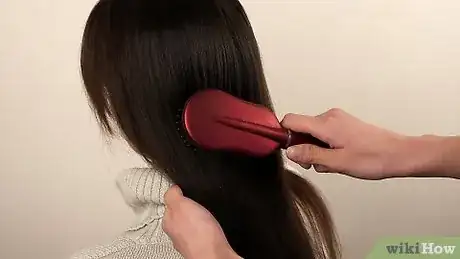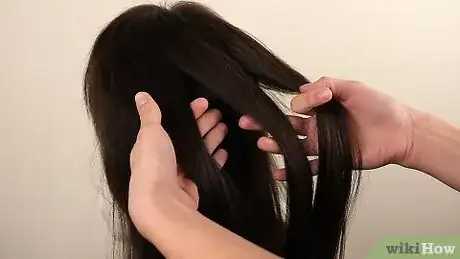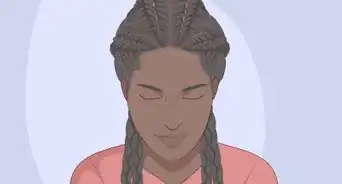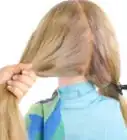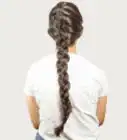This article was co-authored by Sarah Kosakowski. Sarah Kosakowski is a Professional Hair Stylist and the Owner of Alba Salon and Spa based in Cincinnati, Ohio. With a decade of experience, she specializes in bridal and formal hair, blondes, fine hair, and men’s cuts. Sarah received her training at The Aveda Frederic’s Institute and is proud to be a Kevin Murphy Session stylist amongst other accomplishments.
This article has been viewed 118,824 times.
A reverse French braid is a beautiful modification of the classic French braid. It gives a bolder look to your braid, having it pop out and sit on top of your head, rather than weave inward and lay flat with the rest of your hair. A reverse French braid simply requires you to braid you hair as you normally would with a French braid, but instead you cross the hair under the middle portion of hair, rather than over.
Steps
-
1Prep your hair for braiding. Use a wide tooth comb or a brush to remove any tangles and knots from your hair. This is extremely important because as you braid, the ends of your hair are going to get particularly crisscrossed, creating tangles.
- You can do this braid with either dry or wet hair, but for beginners, it may be easier to separate and control the hair if it’s wet.
- Braiding your hair while it’s wet creates a wavy look once your hair has dried and you remove the braid.
-
2Gather your beginning section of hair. Use your thumbs to trace along your scalp, through your hair, and separate the beginning section of hair you are going to use to start your braid.[1] If you want your braid to start at your hairline, use your thumbs to create a smaller, triangle shaped section near the front, top of your head. This section should be about two to four inches wide. If you want your braid to start more toward the middle back of your head, position your thumbs at the side of your head (near your temples), and trace along to the middle-back of your head, to gather your first section. This section will be significantly larger, about 10 inches wide.
- If you have bangs and you want to incorporate them into your braid, start your braid at your hairline.
- For short hair, it may be easier to incorporate all of your hair starting at your front hairline.
- For longer hair, you can start your braid near your hairline, or further down toward the back of your head.
Advertisement -
3Split up the beginning section of hair. Once you have your first section of hair, use your fingers to split it up into three equal parts.[2]
- This section needs to be split three ways evenly, so the braiding portions are all similar in width. If not, your braid could look uneven and lopsided.
-
4Create the first stitchings of the braid. A stitching of hair is anytime a piece of hair crosses another piece. Begin the braid by crossing the right portion of hair under the middle portion of hair. Now, it’s essentially as if these two pieces have flip-flopped; the original right portion of hair is now the new middle piece. Then, cross the left portion of hair under the new middle portion.[3]
- It is very important that the side portions of hair cross under the middle.[4] This is what gives the reverse French braid its signature pop out look.[5]
- These first stitchings of hair are made like a normal braid. There is no new hair incorporated just yet. This gives a small, solid start to the braid where you can then start adding hair into the stitchings.
-
5Incorporate hair into the braid. Now that you have the beginnings stitches, you can start adding hair into the braid. From the right side of your head, add in a new section of hair to the right-side portion of hair.[6] This new portion of hair should be about ½ of an inch thick. Once this new piece of hair is incorporated into the right portion, cross the entire right portion under the middle portion of hair. Do the same procedure with the left portion of hair. Gather a ½-inch piece of new hair from the side of your head, add it to the left portion of hair, and cross it under the middle portion of hair.
- Keep braiding in this manner until you have added all outside hair to the braid, and have reached the nape of your neck.
-
6Finish the braid. Now with all of your hair incorporated either into the braid or into the three braiding portions of hair, continuing braiding the three portions of hair.[7] Once some hair starts fraying from the braid, use an elastic hair tie to secure and finish the braid.[8]
- You can use a clear elastic tie of you have blonde hair, or a black hair tie if you have dark hair.
- You can also bring the three portions of hair over one of your shoulders to make the finishing braiding easier.
Expert Q&A
-
QuestionHow many strands of hair do you need for a reverse French braid?
 Sarah KosakowskiSarah Kosakowski is a Professional Hair Stylist and the Owner of Alba Salon and Spa based in Cincinnati, Ohio. With a decade of experience, she specializes in bridal and formal hair, blondes, fine hair, and men’s cuts. Sarah received her training at The Aveda Frederic’s Institute and is proud to be a Kevin Murphy Session stylist amongst other accomplishments.
Sarah KosakowskiSarah Kosakowski is a Professional Hair Stylist and the Owner of Alba Salon and Spa based in Cincinnati, Ohio. With a decade of experience, she specializes in bridal and formal hair, blondes, fine hair, and men’s cuts. Sarah received her training at The Aveda Frederic’s Institute and is proud to be a Kevin Murphy Session stylist amongst other accomplishments.
Professional Hair Stylist You need to divide your hair into 3 separate parts to do a reverse French braid.
You need to divide your hair into 3 separate parts to do a reverse French braid. -
QuestionCan you do this braid on shoulder length hair?
 Community AnswerYes, but the braids won't be as long.
Community AnswerYes, but the braids won't be as long. -
QuestionMy braid just looks like a Dutch braid. Any tips?
 Community AnswerThey're the same. Reverse French braid is just the more commonly used name.
Community AnswerThey're the same. Reverse French braid is just the more commonly used name.
References
- ↑ https://www.youtube.com/watch?v=wxrxkhxdaf8
- ↑ Sarah Kosakowski. Professional Hair Stylist. Expert Interview. 3 September 2021.
- ↑ https://www.youtube.com/watch?v=wxrxkhxdaf8
- ↑ Sarah Kosakowski. Professional Hair Stylist. Expert Interview. 3 September 2021.
- ↑ http://www.seventeen.com/beauty/hair/advice/a23892/reverse-french-braid-hair-tutorial/
- ↑ http://www.bustle.com/articles/82839-how-to-reverse-french-braid-in-5-steps-then-turn-it-into-a-faux-hawk
- ↑ http://www.seventeen.com/beauty/hair/advice/a23892/reverse-french-braid-hair-tutorial/
- ↑ Sarah Kosakowski. Professional Hair Stylist. Expert Interview. 3 September 2021.
